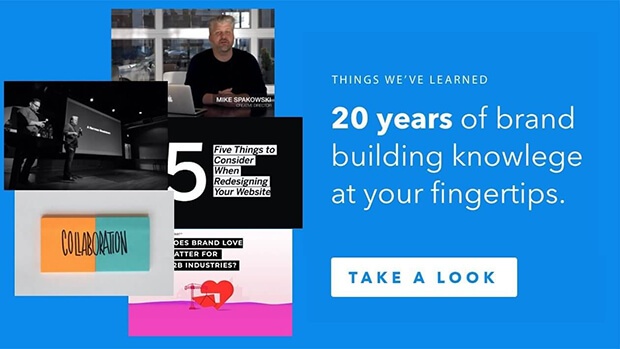How to Build a Brand Worth Falling in Love With
We’ve talked a lot about the power of positioning to create barriers to competition. But we haven’t talked enough about brand love.
“Love” isn’t much of an exaggeration. A brand probably can’t break your heart, but studies have shown that the relationships we build with our favorite brands mirror our personal relationships. As marketing becomes more personalized, more real-time, more ever-present, brands can feel like our friends. We want to protect them, invest in them, advocate for them and see them succeed.
So why should brand love matter to businesses? Because brand love leads to brand loyalty. (And, you know, sales).
It’s a barrier against competition – against price cuts, shiny promises, flashy redesigns, and superior products, services or features – because it’s built on emotion, not logic. If the love is strong enough, competitors will have to go along way to undercut it. Like reinventing the industry entirely a la Netflix, Uber or Airbnb. A tall order.
This kind of relationship doesn’t just happen. It’s earned. To achieve it, there’s one fundamental trait that must exist across every brand component, from the brand’s look and feel, to the user experience, to the company’s internal culture:
The brand must bring people closer to who they want to be, and what they want their world to look like.
(Note that this is true for B2B brands, too. Your buyer’s professional aspirations are built on their personal aspirations.)
Joan Khoury, CMO of Oppenheimer & Co, wrote, “Good branding should always assert the perfectability of all things…A good brand is a door to what ought to be from what is.”
At every touchpoint, the world’s best loved brands represent a promise that a better self and a better world are possible. On sales calls, in customer service chats, in emails, on the web, on packaging, in white papers, on social media and everywhere else, these brands validate and celebrate the identities and deeply-held aspirations of their audiences. Always.
It sounds lofty, but it’s true for even the least pretentious brands. Take Hershey’s, IKEA, and up-and-comer Everlane. Hershey’s represents a world where simple pleasures are just around the corner. IKEA represents a world where good design is accessible. Everlane represents a world where high-quality clothing is ethically made and priced transparently. And these values don’t just live on paper. They’re built into the very fabric of these brands, and they’re obvious to everyone who comes into contact with them.
Side note: I suspect this is also the reason nostalgia marketing is so huge among millennials, from limited edition ‘90s throwback designs to the resurrection of dead or near-dead brands and products like Surge, Lisa Frank, Keds, and Ecto Cooler. It’s the reason I just dropped $50 on a Nickelodeon subscription box. Millennials love these brands because they represent a better world: the world of childhood.
Beloved brands also return favors again and again, building reciprocal relationships in which the brand and the customer work together toward that better self or better world.
Think about this in terms of measurable items. REI, for example, celebrates the sense of community that outdoor adventures can provide, and understands that caring for the environment is essential to keeping that sense of community alive. Building on this vision of community, their REI Program operates like a co-op, providing members with a share of its annual profits. On average, they provide 10% back on REI purchases, and allow members to donate their share to the REI Foundation, which supports environmental initiatives. Not too shabby.
You can also think of this in terms of abstract items, like providing customers with tips and tricks, or simply feelings of well-being. As long as the “favor” reinforces the shared worldview, it’s doing its job.
Keep in mind: none of this matters unless the brand is trustworthy (or – let’s be honest! – has created the appearance of trustworthiness).
Brands can’t make emotional connections with people unless their values and vision appear to be genuine. This can be achieved through tone, transparency, action (“walking the walk”), or the right celebrity endorsement, oddly enough.
Here are some questions to ask yourself, your colleagues, your stakeholders, and your customers as you work to create a lovable brand:
- In what ways – big or small – does my brand represent the promise of “a better world”? How is it contributing to a world that’s easier to live in, safer, healthier, more comfortable, more convenient, more beautiful, or more accepting?
- Does my brand’s vision for this “better world” align with the vision of my customers and employees?
- Is my brand’s vision consistent, or does it change frequently (every quarter, every year) due to competitor activities or other external influences?
- What does my brand provide to customers and employees beyond a product or service? Is what we provide in line with our vision?
- Is my brand worthy of my customers’ and employees’ trust? Why or why not?
Explore the answers and come up with a plan to address each one. At the very least, you’ll find a way to bring value to your customers beyond the products and services you sell. At best, you’ll find love, loyalty, and some seriously intimidated competitors.
WATCH: Jazzy discusses our close relationships with brands, why brand love matters and how businesses can achieve it. Watch below or on YouTube:


